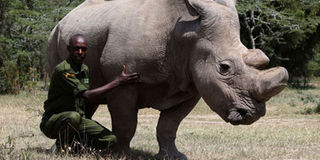What Sudan’s death says about leaders

Mohammed Doyo tends to the world’s last male white rhino named Sudan at Ol Pejeta Conservancy, Laikipia County, on June 18, 2015. PHOTO | JOSEPH KANYI | NATION MEDIA GROUP
What you need to know:
- Sudan’s death is, probably, the first time that young Africans have confronted extinction in their lifetime as something real.
- In Africa, conservation management and diligent environmental stewardship are, then, fairly reliable proxies for broader good governance.
Two weeks ago, the world’s last male white rhino, Sudan, died at Ol Pejeta Conservancy in Kenya.
With northern white rhinos preyed upon to near-extinction, Sudan’s death leaves just two — Najin and Fatu, his daughter and granddaughter, respectively.
The news, while greeted with unsurprising sadness in the conservation world, played out differently in Africa.
Following, especially the comments on Twitter and articles in the media, there was a sense of mortification; that something horrible had happened.
There was little of the cynicism that wildlife is no more than a nature ghetto preserved for Western tourists whose proceeds are pocketed by a corrupt elite.
HEALTH TROUBLES
In decades working on conservation, I have rarely seen this kind of emotion.
At 45, Sudan had already lived long and, with his health troubles, his death didn’t come as a surprise.
The sense of loss is, probably, down to two factors.
For the first, one has to go back to 2016, to the controversial relocation of rhinos from South Africa to Australia.
Australian Rhino Project, the charity behind it, said the plan was “to establish an insurance population and ensure the survival of the species”, and the Australian herd could be flown back to re-establish wild populations in Africa when poaching, which has diminished rhino numbers, becomes less of a threat.
For the rhino, that return might not be possible.
EXTINCTION
Sudan’s death, and the fate of the white horn, is, in part, a dramatic failure by Africa to protect its critical nature.
Najin and Fatu are infertile. The death of Sudan is not just the death of a rhino patriarch. It spells the end of a line.
In an Africa where traditional family ties, clan and, often, ethnicity run deep, that can be jarring.
Sudan’s death is, probably, the first time that young Africans have confronted extinction in their lifetime as something real, not as history or a story in a Discovery Channel documentary.
Fast-forward 30 years. A once-unthinkable idea now looks likely.
In the years to come, an African who wants to see an African rhino — and possibly elephant — is more likely to do so if they travel to a wildlife sanctuary in Australia or some such place than to a park on the continent. The meaning of that has to be unsettling.
DROUGHT
Which ties to the second issue thrown up by the fate of the rhino.
With parts of the continent recently facing the worst droughts in two generations, and alarms about cities such as Cape Town in South Africa running out of water, there is a sense that disappearing wildlife and wild lands are a symbol of a deeper malaise.
There have already been warnings that the world didn’t quite heed.
Lake Chad, once one of Africa’s largest and a lifeline of more than 40 million people, is dying.
Over 60 years, its size has shrunk by 90 per cent as a result of extended drought, overuse and other climate change pressures.
ILLEGAL LOGGING
Beyond making the case for rallying to see ecological crises as having potential for regional and global security impacts, at the national levels, failure to police protected forests against illegal loggers and wildlife parks against poachers is not a dysfunction that ends in the bushes.
It will often express itself in a failure to deal with crime on the streets, corrupt government, dangerous dalliance between criminals and sections of law enforcement and dry taps.
It is, perhaps, no accident that Botswana, which has the best conservation record in Africa, is ranked by Transparency International as the least corrupt country on the continent — even compared to the fictional Wakanda in Marvel’s superhero blockbuster Black Panther.
It’s also one of Africa’s most democratic, stable and richest countries.
Rwanda, East Africa’s least-corrupt country, leads the region in several other rankings, including the World Bank’s Ease of Doing Business, and tops the continent in effectiveness of government.
GOVERNANCE
It’s also a model of conservation, especially of the mountain gorillas, for which it has the biggest global naming ceremony — or for any other animal — called Kwita Izina.
In Africa, conservation management and diligent environmental stewardship are, then, fairly reliable proxies for broader good governance.
It is a less complex task than running a country.
A government that can’t secure a forest that is a water catchment will struggle to build storm drains to carry away flood waters or to maintain the sewer system.
And the fellow who kills a rhino and traffics its horn to Asia to be ground into an aphrodisiac or to treat gout is likely the same person who has a firm that will bribe to get a $25 million contract, bank half of the money abroad and build a shoddy road — if at all.
Sudan is what happens when the bad guys win.
Mr Sebunya is the president, African Wildlife Foundation (AWF). [email protected]




